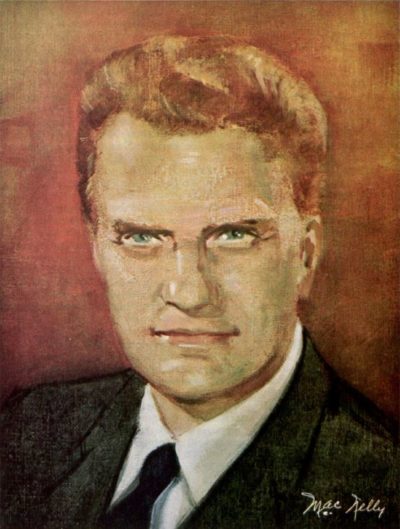A Vivid Portrait of the Famous Revivalist Billy Graham

Evangelist Billy Graham passed away today at age 99. With good reason, Graham can be credited with shaping American society.
When he came to national attention in the 1950s, he was the new face of Christian evangelism. Graham was undeniably charismatic, but without the emphasis on hellfire and theatrics that Americans usually associated with evangelical preachers. He was young, handsome, approachable, strongly moral, and had much to say that many Americans agreed with.
He addressed concerns of living a good life in the shadow of the Cold War. Americans often felt overwhelmed in the post-war world, with its threat of sudden nuclear annihilation. They were looking for answers, and Graham had them.
He offered hope, reassurance, and a scripturally based faith that addressed the way they lived. And he attacked communism relentlessly. He saw communism and Christianity as mutually exclusive; one or the other would eventually pass away. Graham built an unyielding resistance to the Soviet Union, uniting patriotism with Christianity.
Graham quickly rose from obscurity in 1949, when a revival he was hosting in Los Angeles received highly favorable media coverage. His fame continued to grow nationally through the decade, and a successful 1954 revival in England brought him international renown.
The Billy Graham Evangelistic Association spread the word through radio, then television, becoming a multi-media enterprise that other evangelical ministries have followed. Graham made no apologies for the effectiveness of his outreach: “We are selling the greatest product on earth,” he said. “Why shouldn’t we promote it as effectively as we promote a bar of soap?”
When Harold H. Martin profiled him in a 1963 cover story in The Saturday Evening Post, Graham was a powerful force in American religious life and politics. Martin wrote, “Many who propound [the gospel] are more eloquent preachers than Mr. Graham, and many are deeper theologians. None, however, has carried the message to more people in more lands, nor presented it with more power and authority, nor stirred a deeper response in his hearers.”
Throughout his career, Graham was attacked by both conservative and liberal theologians. Fundamentalist Bob Jones Sr. of Bob Jones University said of Graham, “”Billy Graham has done more harm to the cause of Christ than any man in history.” Progressive clergy found his message too simplistic for the “complex tasks of justice in the community.”
But many Americans found his message of redemption uplifting, and admired his integrity and humility. He told Martin, “What good my ministry has done I’ll never know until I get to heaven.”
